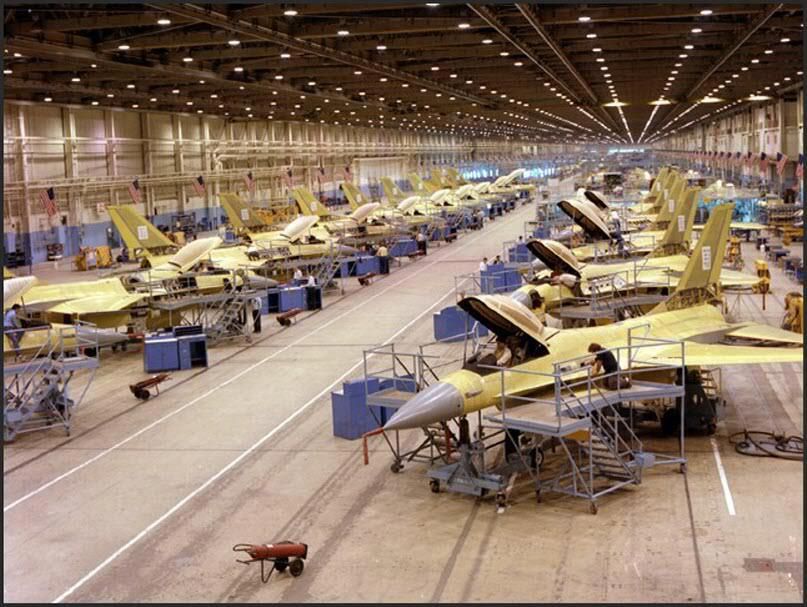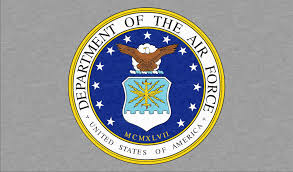
The United States Air Force
The United States Air Force (USAF) in 1994 had historically been reduced by 30% from a 1986 strength of around 608,000 to size of 426,000 and was shrinking rapidly. In Northern Fury, due to increased tensions in Europe and around the globe, the strength although reduced from the mid ‘80s, but by a much smaller margin. The Northern Fury USAF has about 600,000 personnel in 1994 and this number has been stable for the past two years. Many of the changes implemented by the various BRAC (Base Realignment and Closure Commission) reviews (1988, 1991, 1993) do not occur, realignment where it was reasonable happened but most bases remain open, specifics are noted where it makes a difference. Structurally the changes that occurred historically remain extant because they made sense in an evolving world. The fundamental structure of the USAF looks like this:

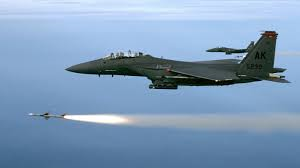
Air Combat Command
Air Combat Command (ACC), headquartered at Langley AFB, Virginia, is the primary provider of combat air forces to reinforce regional commands around the globe or to defend North America. ACC’s main focus is the training and preparation of combat ready fighter, bomber, reconnaissance, rescue and Battle management forces for rapid deployment and employment. This is a large command with over 230,000 regular and reserve personnel and over 1,000 aircraft.
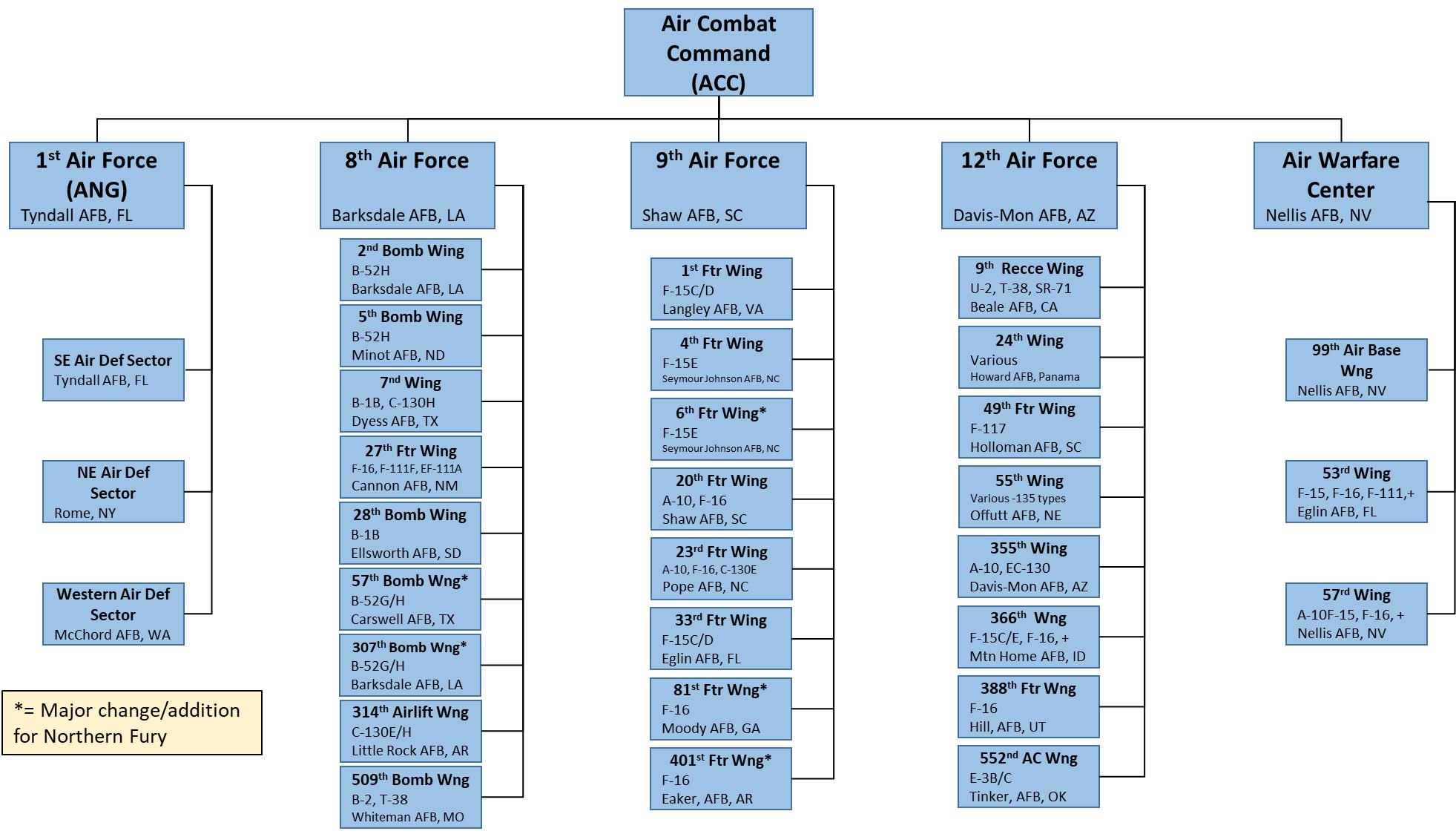
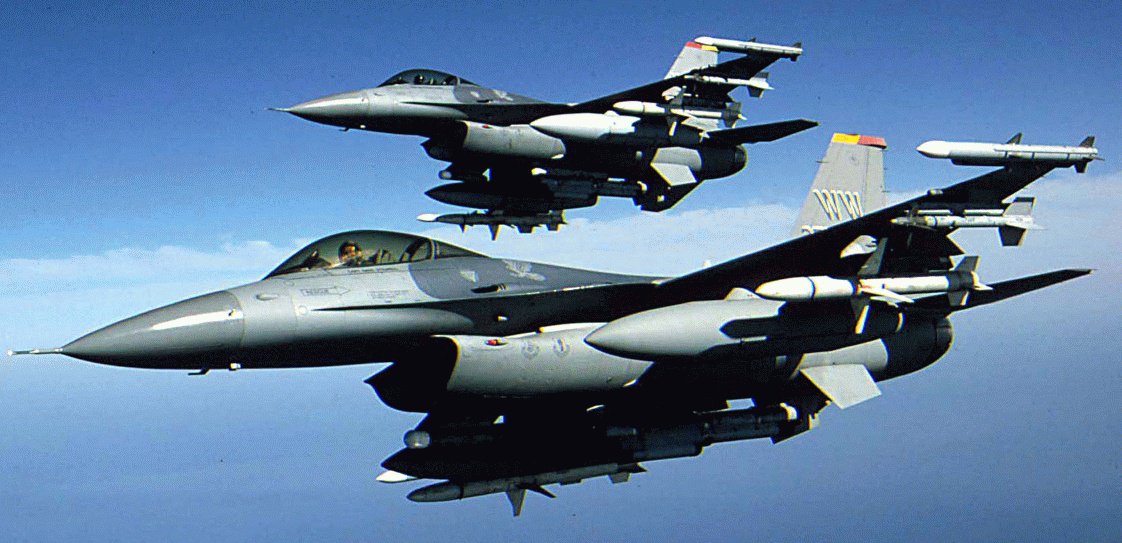
Air Mobility Command
Air Mobility Command (AMC) is another very large command which provides the USAF and the US Armed Forces as a whole with global rapid deployment options. This command is constantly busy performing air lift, air refueling, aeromedical evacuations and many other minor tasks every day of the year. With 125,000 personnel and about 925 airframes, this is the second largest command in the Air Force.
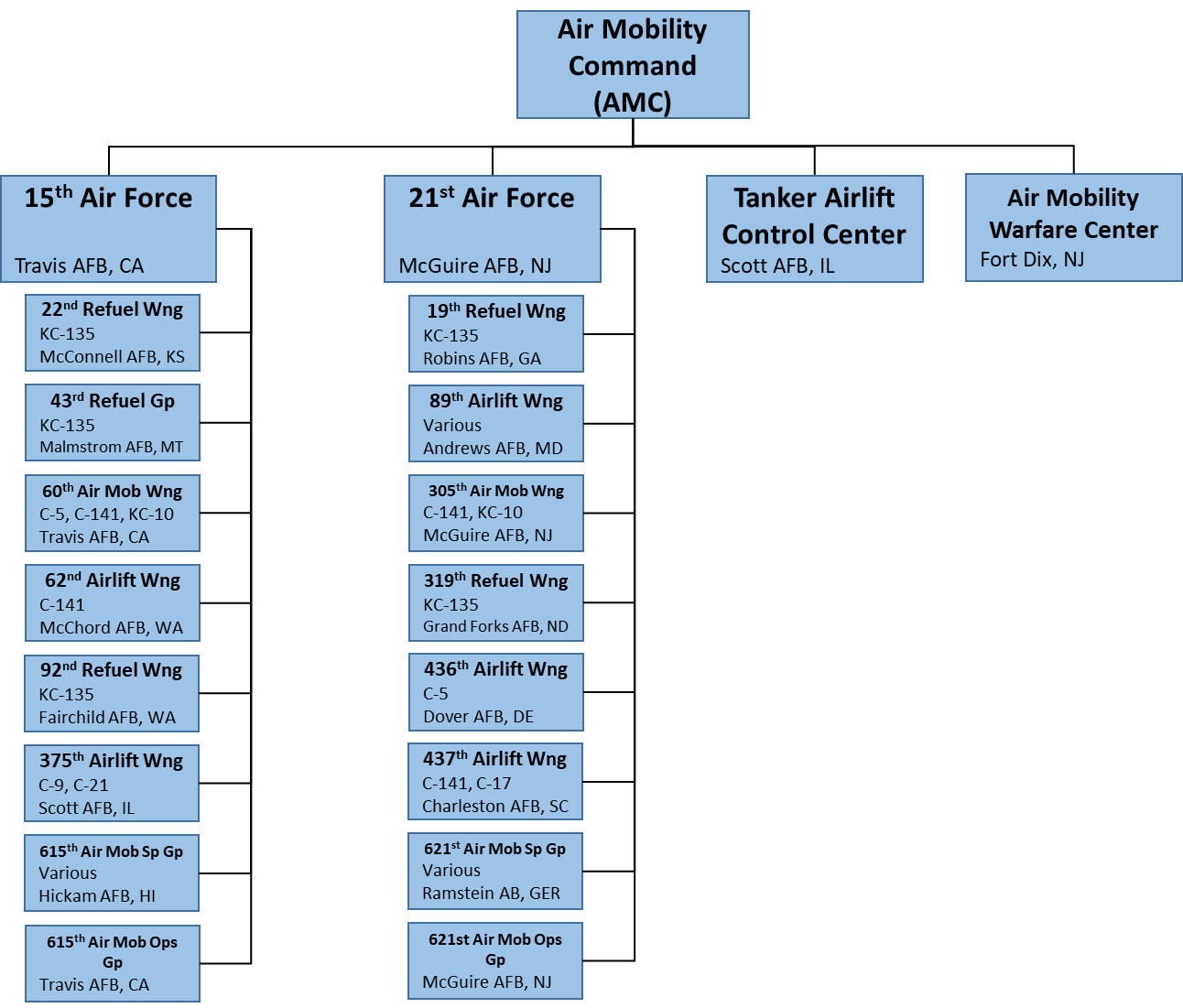
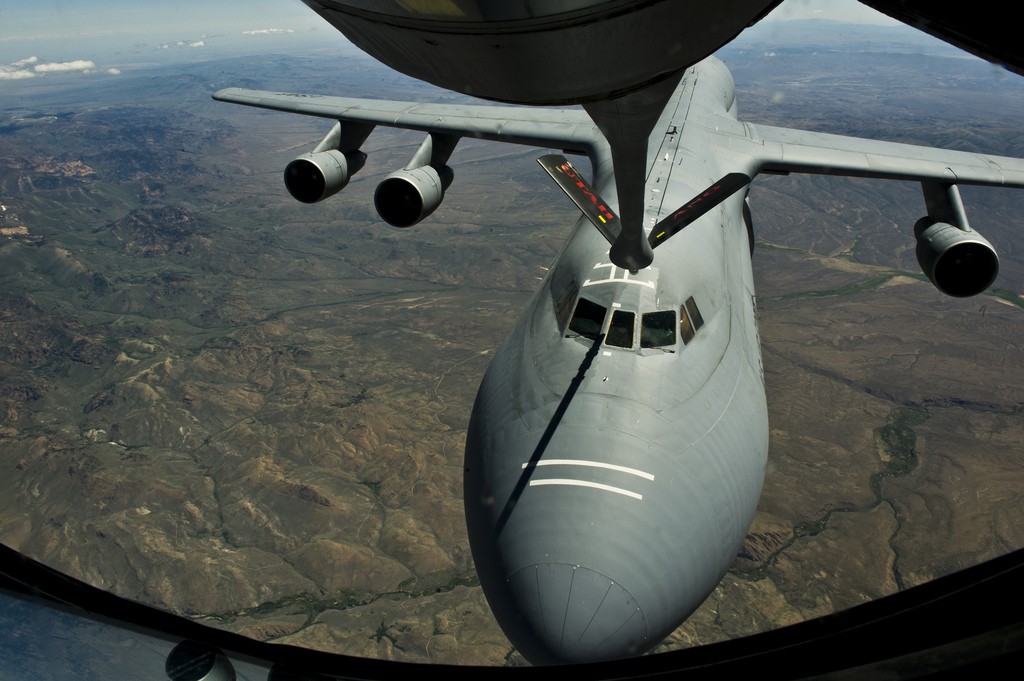
Pacific Air Forces
Pacific Air Forces (PACAF) are the USAF’s forward deployed combat and support elements in the Pacific theatre. Although relatively small with 46,000 personnel and about 330 aircraft, this still represents a significant force in the region, over 260 of the aircraft being front line combat types. One of the major tasks performed by PACAF, besides deterrence, is to train with Asian and Australian Air Forces as a way of leveraging the combat power of those nations toward a unified command system.
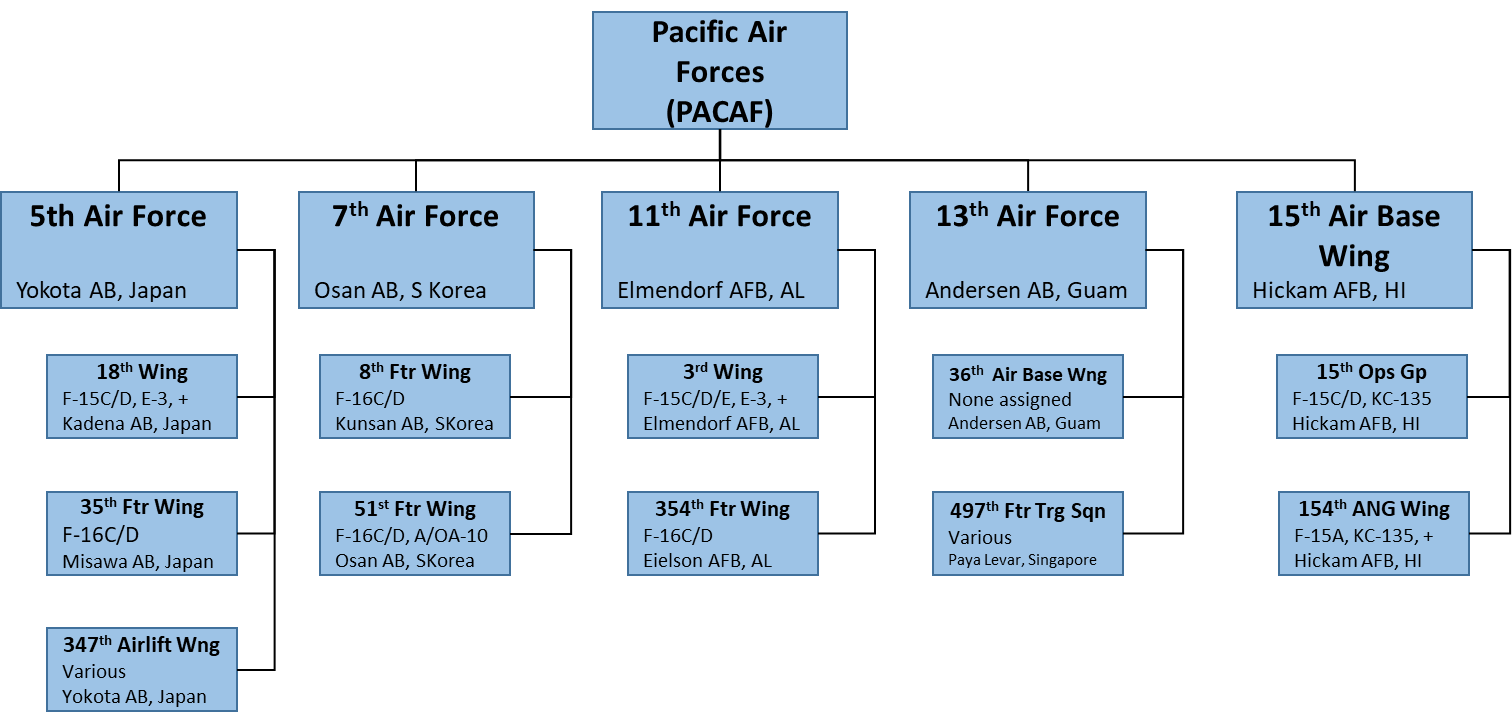
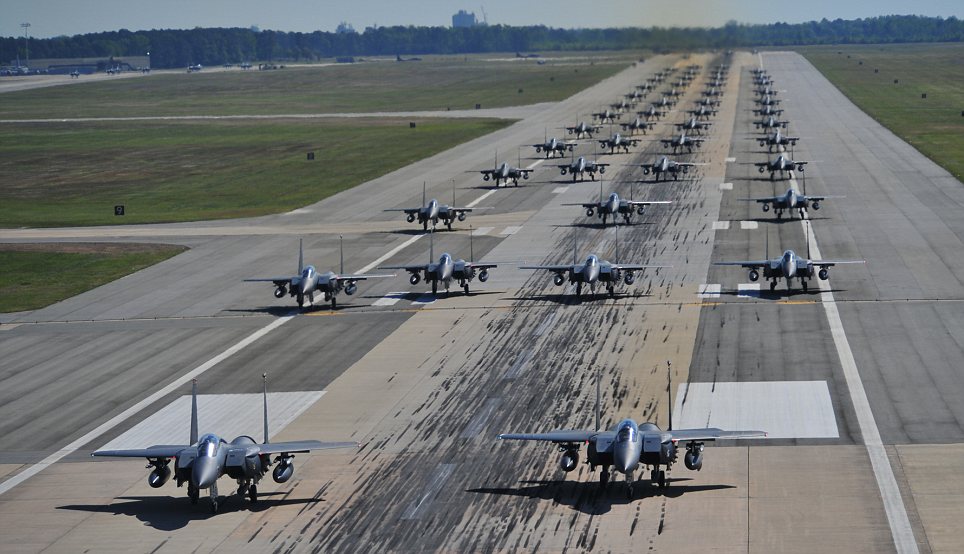
US Air Force in Europe
US Air Force in Europe (USAFE) with its HQ at Ramstein, Germany, supplies forces to Allied Command Europe (ACE) through dedicated air wings under the control of the various NATO Air Forces. 2 and 4 Allied Tactical Air Force (ATAF) in northern Europe are both under the command of Allied Air Forces Central Europe (AIRCENT), essentially USAFE HQ under a different name. For forces allocated to southern Europe, primarily 16th US Air Force, NATO’s 5 and 6 ATAF will control operations under the direction of Allied Air Forces Southern Europe (AIRSOUTH) located at Naples Italy.
Unsurprisingly, the most significant impact of Northern Fury’s changes occur in Europe. Historically, after ‘Peace Dividend’ reductions, only eight Fighter Squadrons in three wings remained in Europe with about 175 front line combat aircraft. In Northern Fury, there are 12 Fighter Wings remaining in Europe, with 28 Squadrons and another 8 are on immediate recall from the Continental US (CONUS). This totals up as 860 front line aircraft and between 50 and 100 tankers, transport and reconnaissance aircraft in support. USAFE will grow well beyond this as the well-practiced flyover reinforcement program continues, swelling to more than double this number.
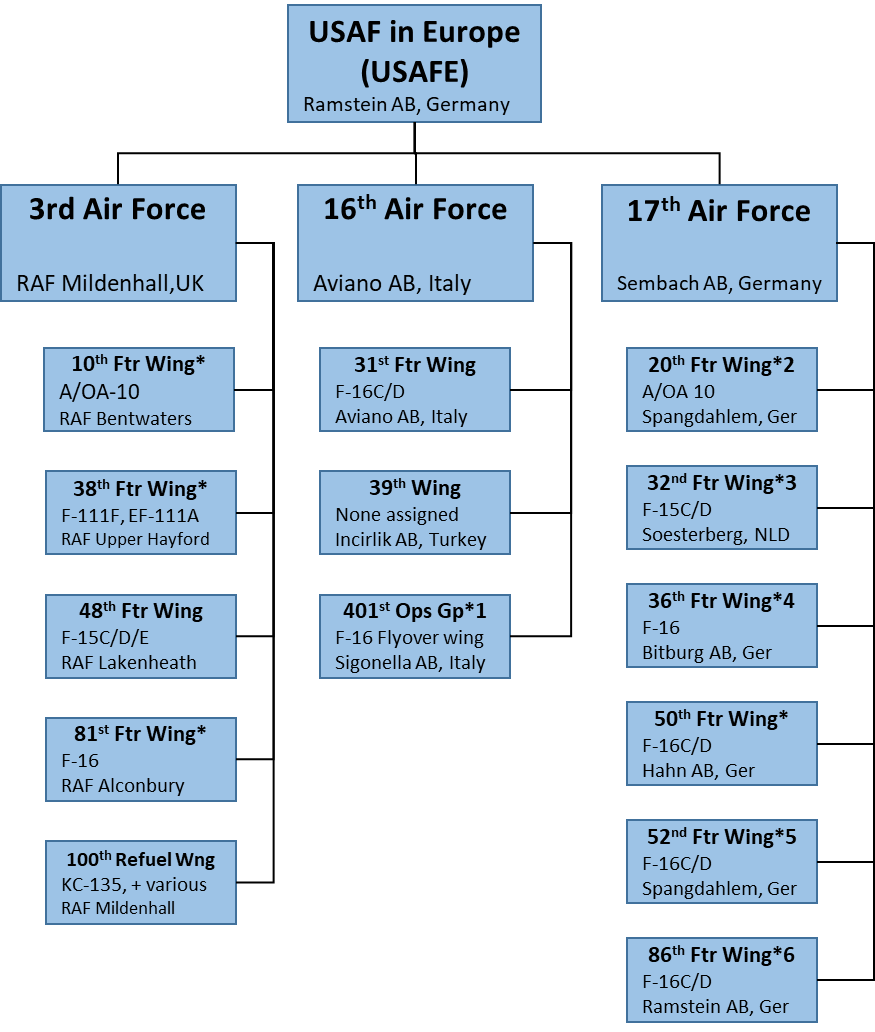

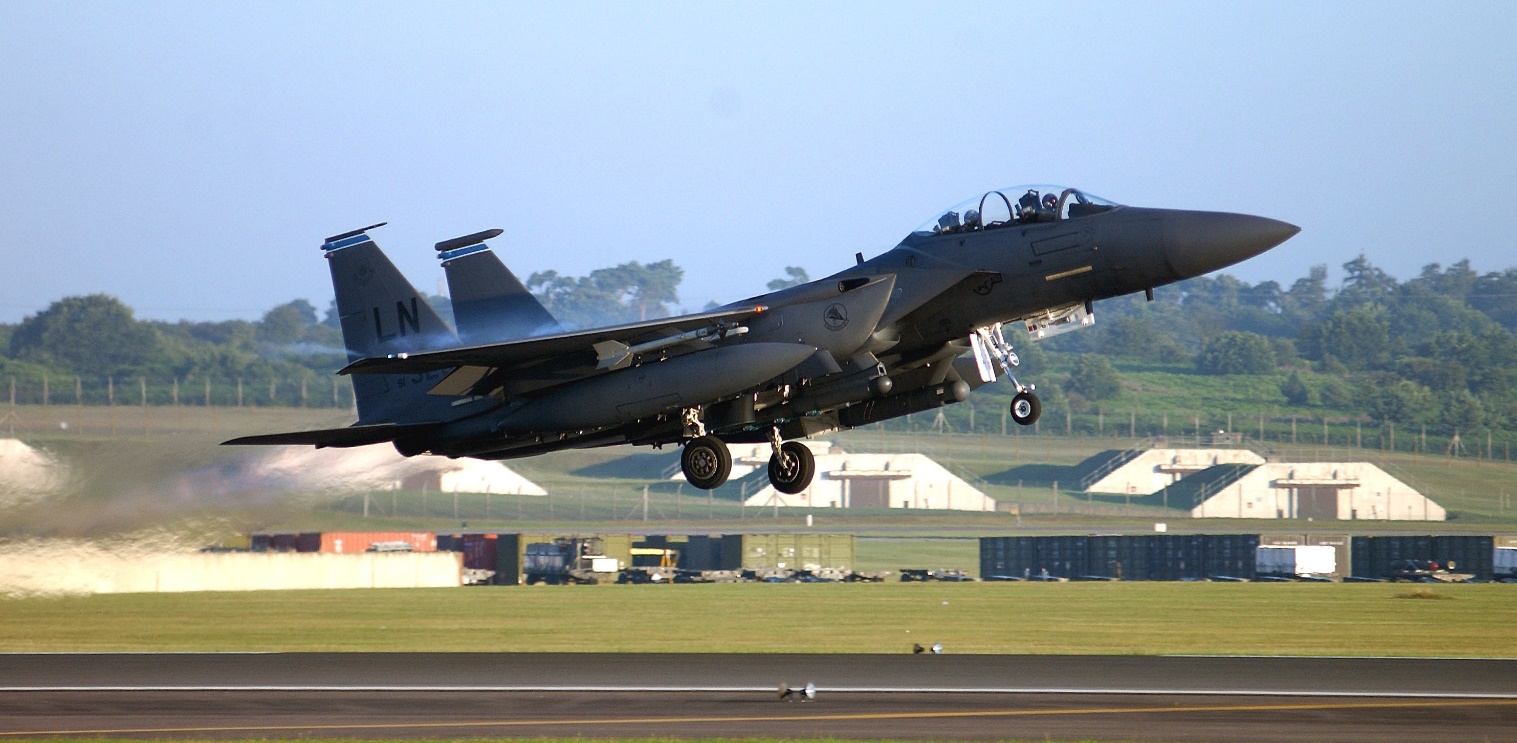
Air Force Special Operation Command
Based at Hurlburt Field, Florida, the Air Force Special Operation Command (AFSOC) only became a separate command in May of 1990 when the former 23rd Air Force was re-designated to this role. AFSOC has a wide ranging list of tasks including:
Providing combat controllers for air to ground coordination of airpower. This function is being consolidated within AFSOC from ACC, PACAF and USAFE but the capacity remains in those commands
Providing Combat Search and Rescue (CSAR) services worldwide
Operating all airborne weather services for US Army and USAF worldwide, as well as providing aircraft to NASA (National Aeronautics and Space Administration) and NOAA (National Oceanic and Atmospheric Administration) which includes the US National Weather Service.
Operating airborne psychological operations platforms.
Operating a squadron of AC-130 Spectre gunships for close air support
Operating a fleet of ‘Combat Talon’ C-130 special mission aircraft for stealthy infiltration of special forces personnel.
Operating a fleet of ‘Combat Shadow’ C-130 special mission refueling aircraft.
Operating a fleet of ‘Pave Low’ and ‘Pave Hawk’ helicopters for CSAR, insertion and extraction missions.
AFSOC is a small, agile organization which runs its own school, test and evaluation unit and deployable Command and Control elements. Operating a fleet of over 100 special mission C-130s, 36 MH-53 heavy lift helicopters and several MH-60’s, this force can deploy elements globally either as individual aircraft or as mission tailored groups on very short notice.
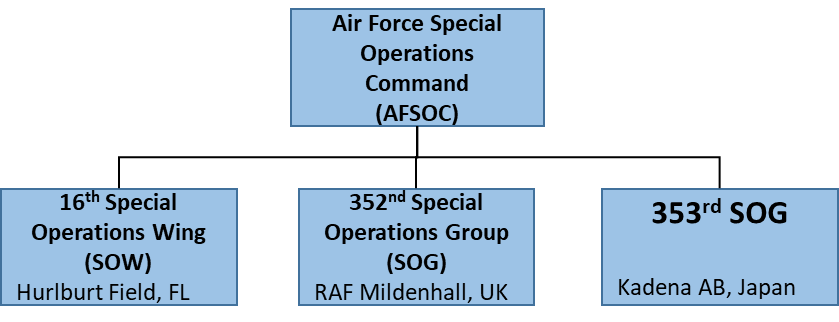
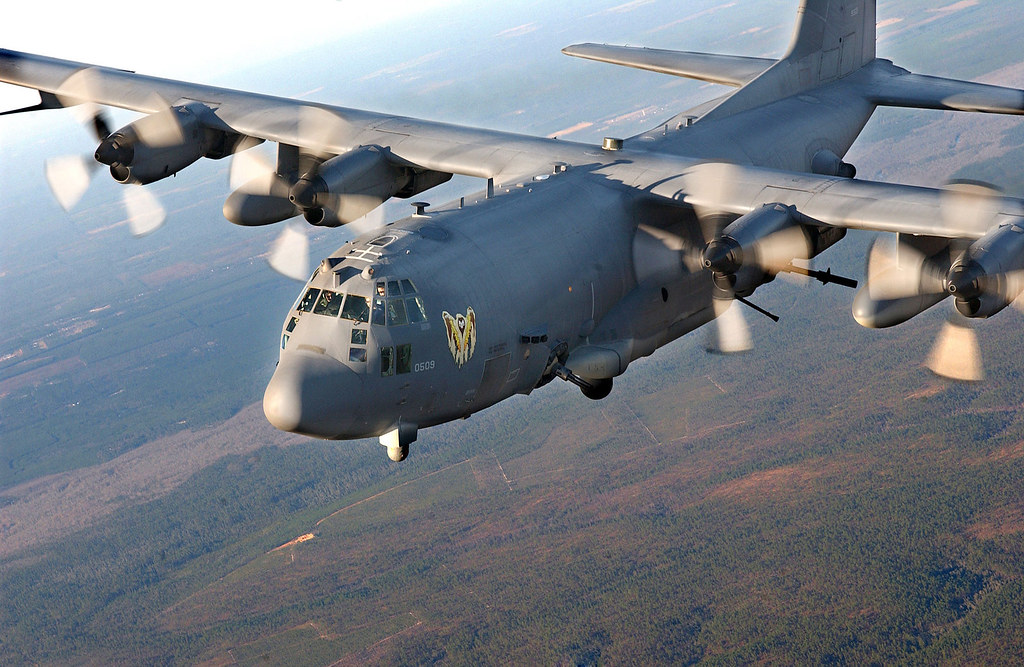
Air Force Space Command
Air Force Space Command (AFSPC) is another new command, it was established in 1982 to control all US military satellites, launch vehicles, space tracking and ballistic missile warning systems. The role of AFSPC increased substantially in 1993 when it inherited responsibility for all Intercontinental Ballistic Missiles (ICBM) from the defunct Strategic Air Command (SAC). AFSPC provides ready ICBMs to US Strategic Command (USSTRATCOM), a unified command responsible for the employment of all US nuclear forces. Additionally, the commander of AFSC is also the commander of the North American Air Defense Command (NORAD), the bi-lateral command between the US and Canada for defending North American airspace from intrusion. This relatively small command has about 39,000 personnel, half of them civilian, but is located in over 80 locations around the world. Two numbered Air Forces in the command coordinate and control 580 ICBMs and over 50 communications, GPS, reconnaissance, ballistic missile warning and weather satellites. (Note, the structures involved in space /assets, ICBMs, NORAD and national reconnaissance have gone through numerous changes over time)
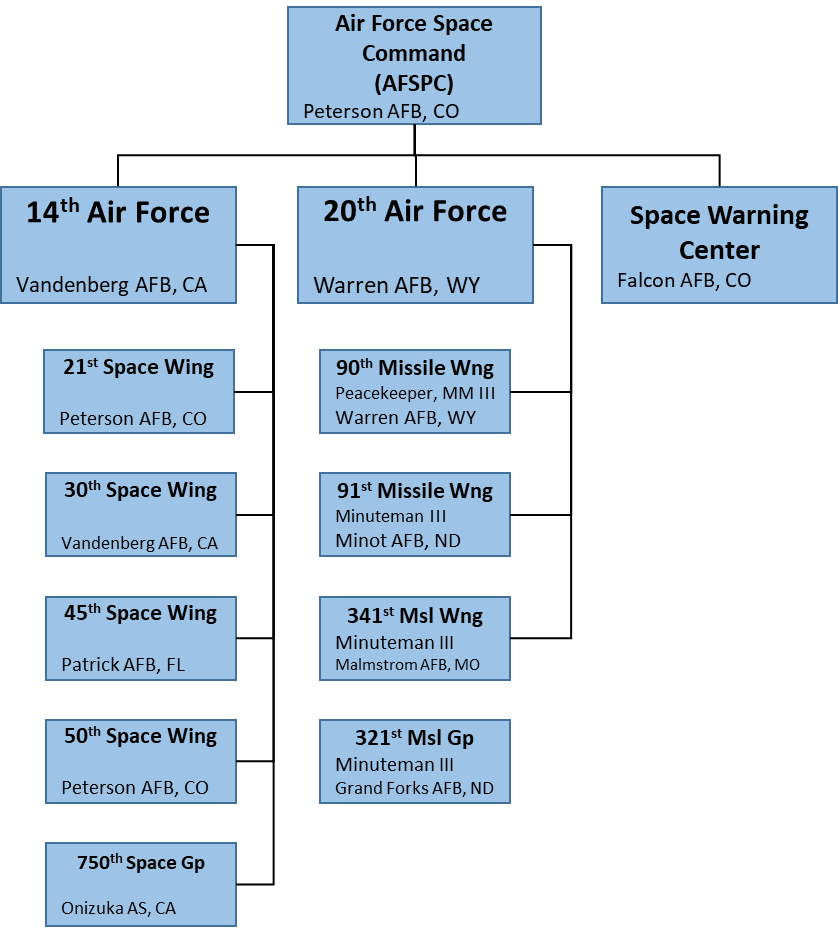
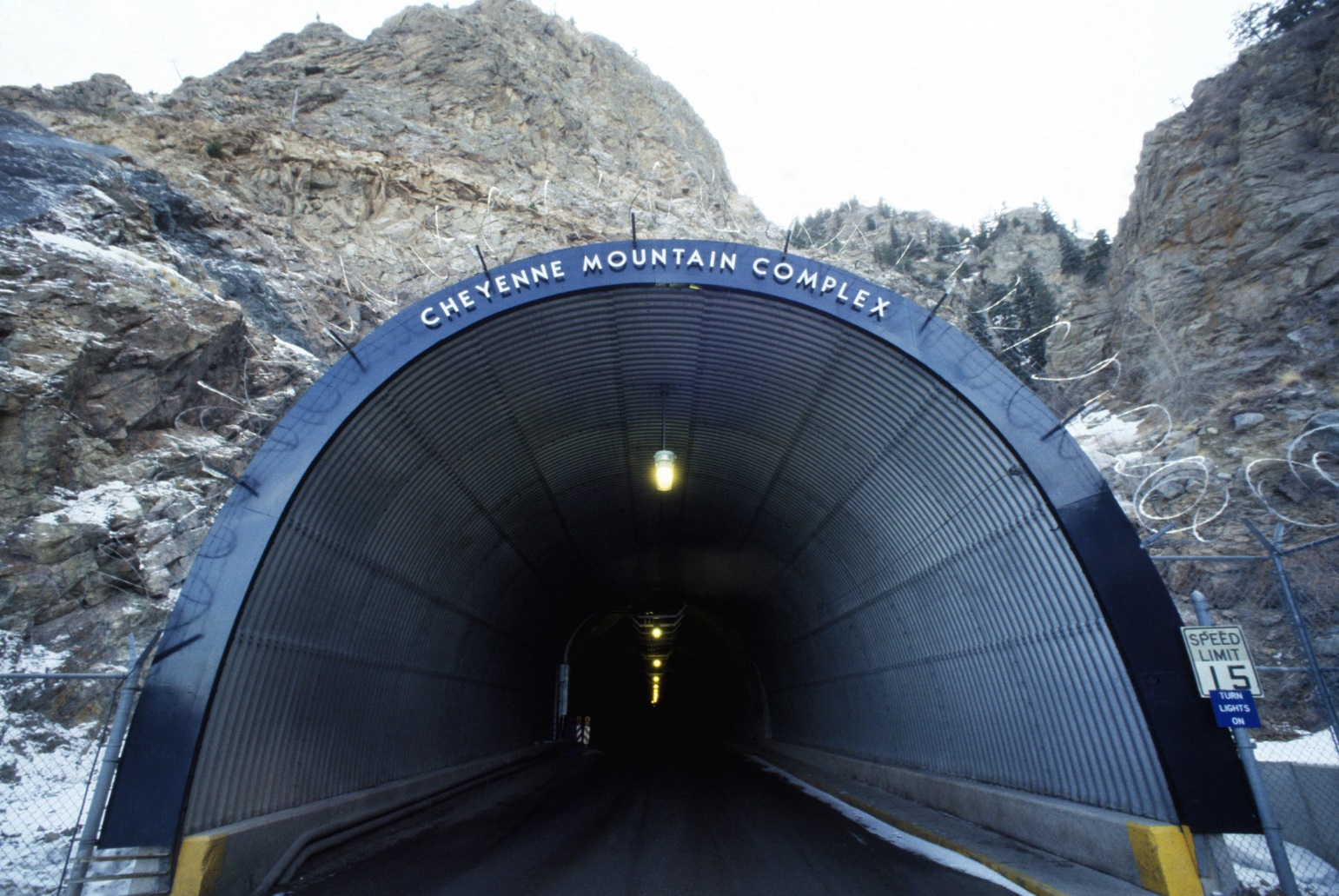
Air Force Reserve
In 1994, the Air Force Reserve (AFR) is an agency within the Air Force, it does not become a command until 1997. As an element with 80,000 personnel and nearly 500 aircraft however, the Reserve is a major component of the USAF. Many of the wings and squadrons of the AFR are ‘associated’ with regular USAF wings and squadrons, primarily in AMC where the aircrew often share aircraft or combine regular and reserve on the same crew. Within the AFR structure there are three numbered Air Forces, 37 wings, 128 groups and about 400 squadrons (many without aircraft). There are some minor changes due to the Northern Fury setting but nothing significant. Not all detail is shown in the diagram below:
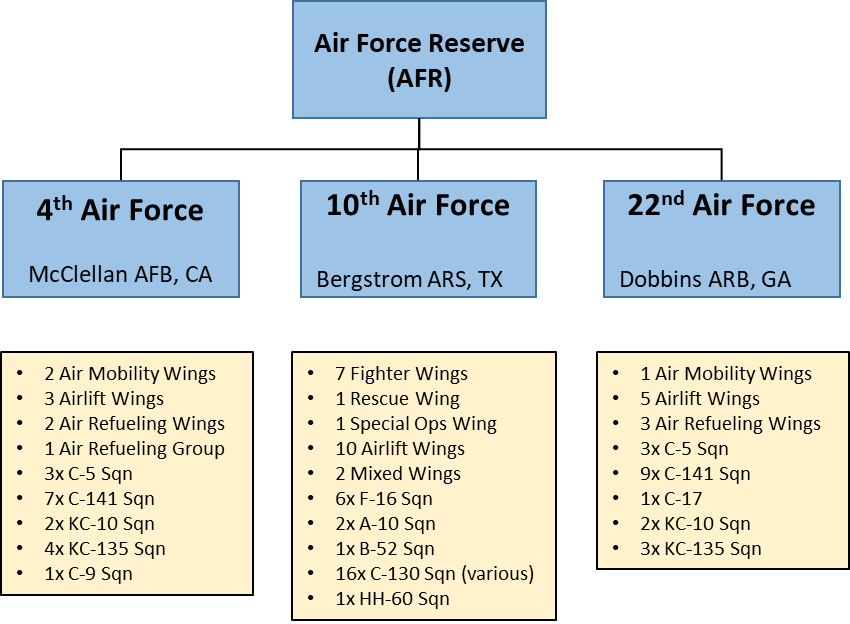
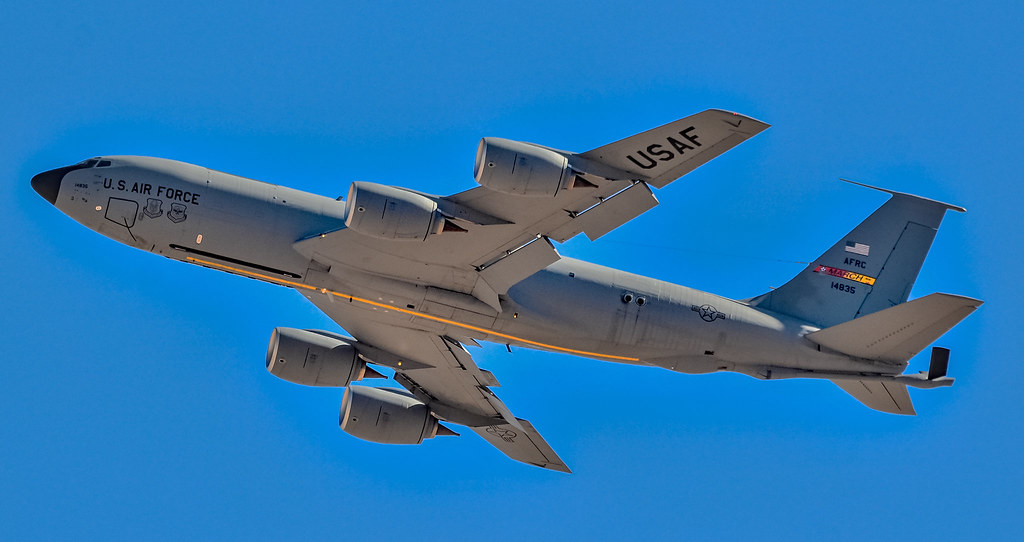
Air Force National Guard
Commonly referred to simply as the ‘Air Guard’ or simply the ‘Guard’ this is another large element of the USAF with over 111,000 personnel flying in 88 wings from every state of the country. The Air Guard provides trained units and people directly to the other commands. Unlike the ARS, these units belong to the State Governors until federalized for operations. Standing agreements exist for NORAD and many other domestic activities, but special permissions are needed to deploy Air Guard units overseas. No numbered Air Forces are operated by the Air Guard and many wings consist of only one squadron. Northern Fury has some significant changes that impact this element, primarily because the active air force maintains many squadrons that were historically deactivated. By 1994 the Air Guard was receiving a significant number of very new aircraft as regular units closed down, but since that does not happen, the Guard was maintaining many older aircraft until production of newer airframes could catch up to demand. The Air Guard flies over 1,500 aircraft in 109 squadrons as follows:
7x F-15A Squadrons of 24 aircraft each, 3 are for NORAD, one is in Hawaii;
29x F-16ADF Squadrons of 18 aircraft each, 14 are for NORAD;
3x F-16 Block 25 Squadrons of 24 aircraft each;
1x F-16 Block 50 Squadron of 24 aircraft, half of that Squadron is in the Persian Gulf;
3x F-4E Squadrons of 24 aircraft each;
1x F-4G ‘Wild Weasel’ Squadron of 24 aircraft;
2x RF-4C ‘Reconnaissance’ Squadrons of 18 aircraft each;
3x A7D Squadrons of 18 aircraft each;
5x A-10 Squadrons of 18 aircraft each;
1x EC-130E ‘Commando Solo’ Squadron of 8 aircraft;
19x C-130E/H varying between 8 and 12 aircraft each (1 Sqn is forming and has 5);
2x C-141B Squadrons of 8 aircraft each;
1x C-5A Squadron of 8 aircraft;
1x CT-43A Squadron of 6 aircraft working with ATEC;
1x C-21A Squadron with 4 aircraft for VIP transport;
20x KC-135 Squadrons with 7 to 10 aircraft each;
1x T-38 Squadron with around 32 aircraft working for ATEC;
1x C-130E Training Squadron with 10 aircraft working for ATEC;
1x F-4G/RF-4C Training Squadron with at least 12 of each working for ATEC;
2x C-130P Rescue Squadrons with 5 aircraft each
2x HH-60 Rescue Squadrons with 8 aircraft each
1x Mixed Rescue Squadron with 4x C-130P and 6x HH-60.
2x Rescue Jumper Squadrons.
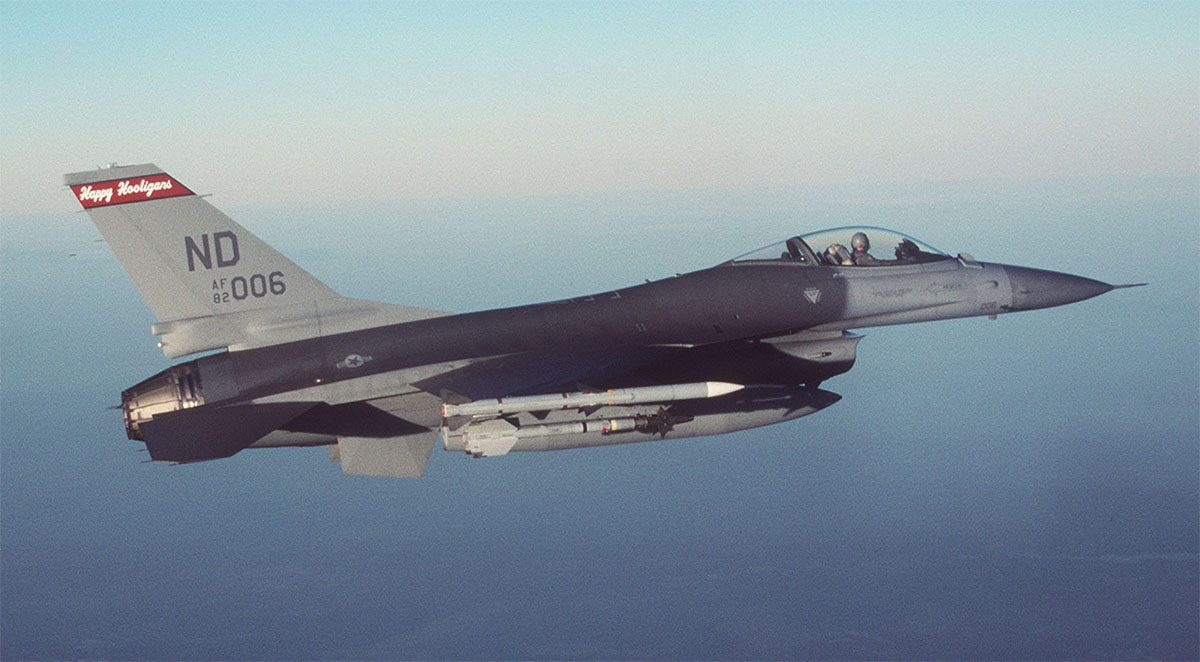
Air Force Training and Education Command
The Training Command (ATEC) is worth noting simply because of the scale at which the USAF conducts training. At any time, there are over 60,000 assigned personnel and around 350,000 students within the command. Although flight training is only one of many functions of ATEC, it operates over 1,500 aircraft in two numbered air forces, including over 350 front line aircraft!
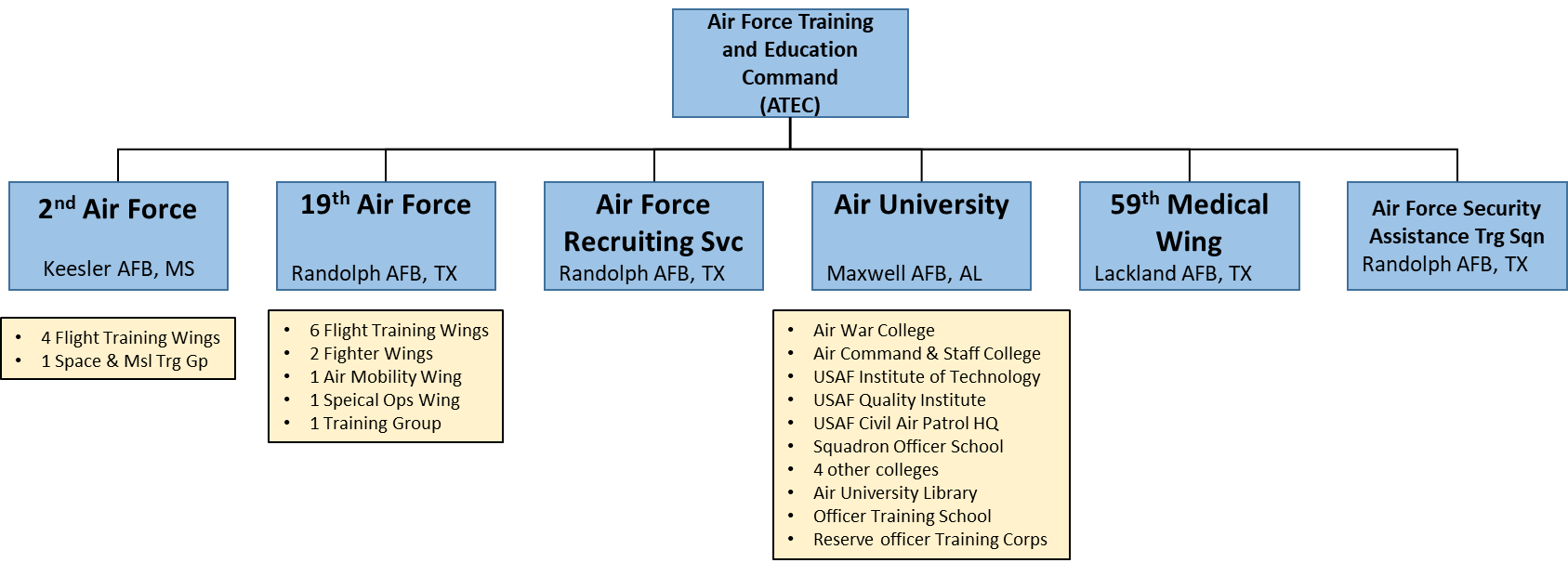
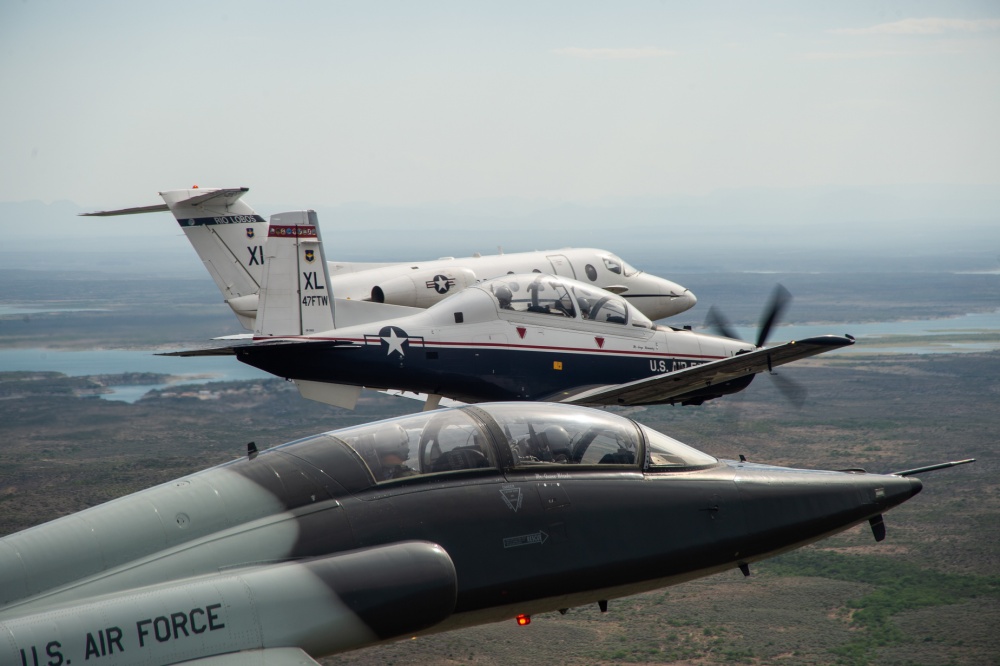
Air Force Materiel Command
Procurement, life cycle management, testing and evaluation as well as routine logistic support is the role of the AFMC. With over 115,000 personnel and operating 40 different types of aircraft, this is a large command. AFMC also operates the ‘Test Pilot’ school and works with industry to develop and evolve aircraft.
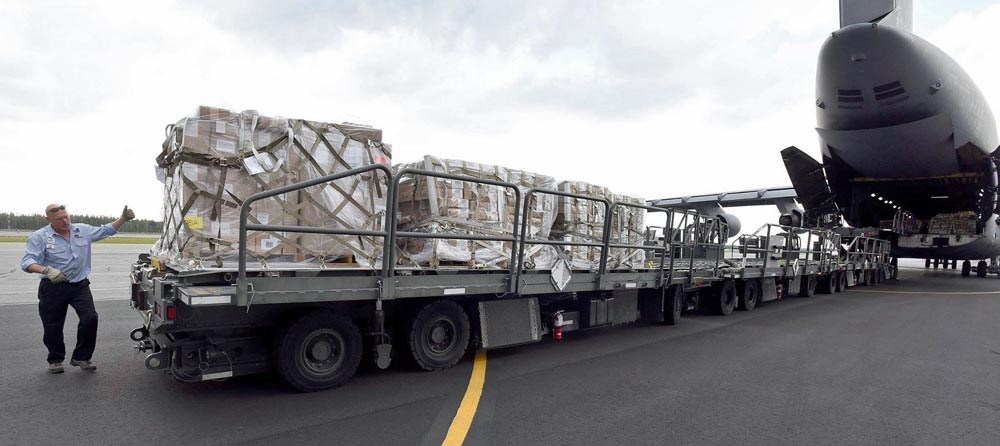
Northern Fury
With the significant increase of tensions in Europe caused by the Northern Fury storyline, US lawmakers and hawks amongst the defense community watched a resurgence of hard liners with a mix of caution and anger. Increased Soviet aggressiveness as early as 1989 and then the 1991 coup that deposed Gorbachev signaled a change in the path of history. Tensions rapidly ramped up as the Soviet Union exerted pressure on Poland and Germany with the apparent goal of minimalizing NATO’s and ultimately the United States’ influence on Europe. As a reaction to these developments the US Government embarked on a plan to rejuvenate the Reagan era programs of the 1980’s. Three major initiatives were undertaken to stem the decline of combat power within the air force:
As mentioned earlier, halting the base and wing closures recommended by the various BRAC committees allowed the structure of the USAF to remain relatively unchanged, from the late ‘80s.
In order to maintain force levels, several airframes were retained in service longer than they were historically. A major impact of this was on the Air Guard, as they did not receive the windfall of new equipment in the early ‘90s. Several squadrons still fly F-4 Phantom and A-7 Corsairs, and many more retained the legacy F-16ADF (Air Defense Variant). There is a smattering of other airframes that will be retained longer than planned such as the F-4G Wild Wesel, the F-111F and B-52G, these will be mentioned in the detailed aircraft section later.
Ramping up, or more accurately, not ramping down of production. Although there are some specialty aircraft that this policy affects such as the EC/MC/AC-130 series where Northern Fury sees about 27 more airframes in use, the big impact is in front line fighter aircraft and the B-2 Bomber.
A total of eight B-2 Spirit bombers are in service (AV-7 to AV-12, plus AV-5 & 6 held by ATEC). These have formed the 393rd Bomb Squadron at Whiteman AFB. Training, testing and evaluation is ongoing with the two ATEC airframes not ready for immediate operations.
The F-15E Strike Eagle, all 200 ordered plus 6 replacement aircraft had been delivered by early 1992, a further order was placed for 100 airframes early enough to continue production at capacity (42/year) until 1993. Therefore, an additional three squadrons are available and the 6th Fighter Wing at Mountain Home AFB was formed. 550th Fighter Squadron, the operational conversion unit for this type is due to deactivate later in 1994, but remains extant within ATEC when Northern Fury commences.
The single largest impact of retained production is the F-16 Falcon. Historically the late ‘80s and early ‘90s saw a massive downsizing and sell-off of this ubiquitous and versatile fighter. Many went to the Air Guard, many others went into long term preservation and yet more were sold to allies. In Northern Fury the 1988 level of production (180/year) was maintained right through 1993 and is planned to continue for at least 3 more years. Factoring in a slightly higher level of attrition, this production results in an additional 442 airframes being available, all at the Block 40/42 and 50/52 standard. Combined with retaining some older aircraft in the Air Guard, not retiring many F-16ADF, and canceling several foreign sales a net increase of 15x F-16 Squadrons are available to the USAF.
